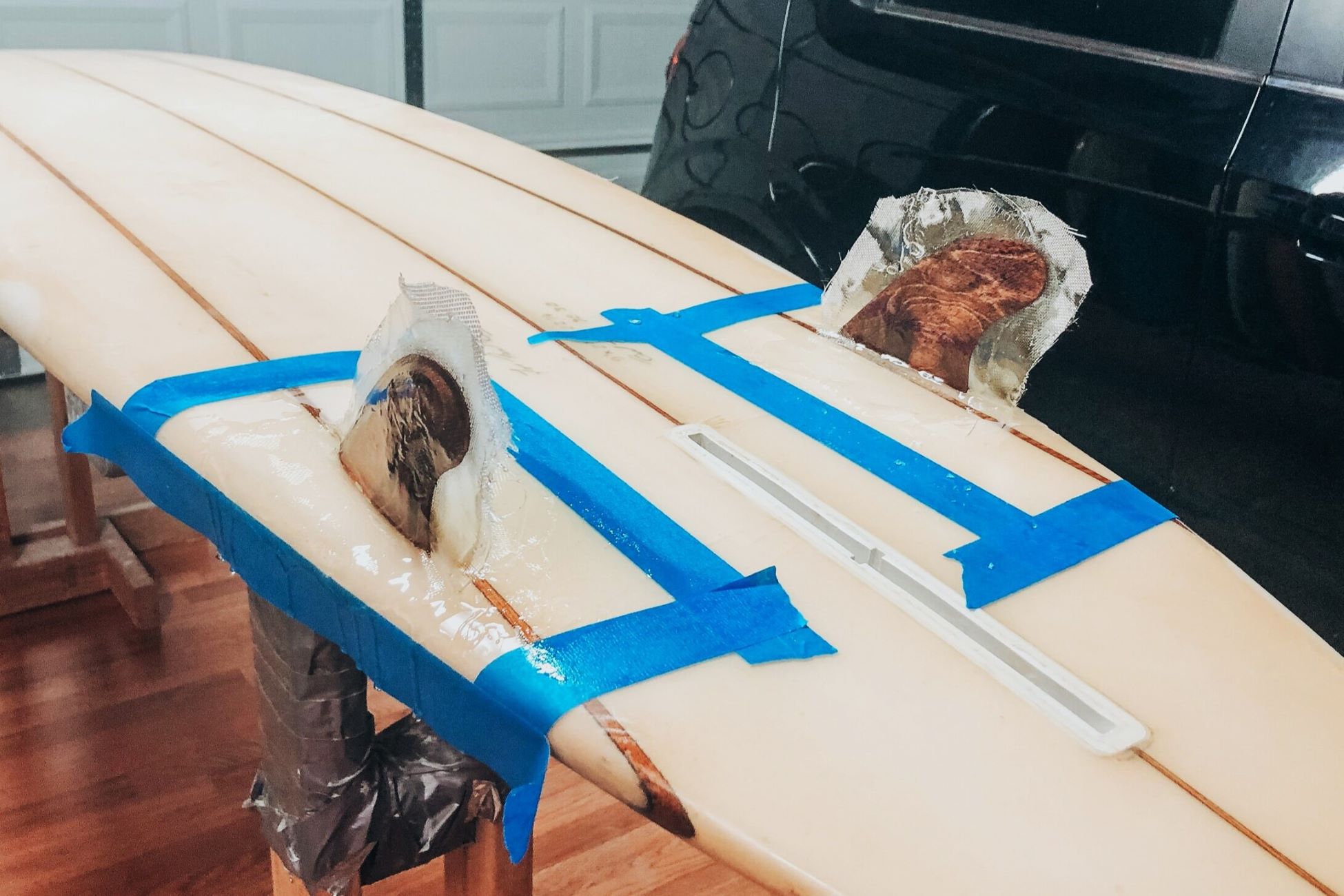

Articles
How To Store A Surfboard
Modified: January 5, 2024
Discover the best articles about how to store a surfboard and keep it in top condition. Find expert tips and techniques for proper surfboard storage.
(Many of the links in this article redirect to a specific reviewed product. Your purchase of these products through affiliate links helps to generate commission for Storables.com, at no extra cost. Learn more)
Introduction
Storing a surfboard properly is essential to ensure its longevity and performance. Whether you’re a professional surfer or a casual beachgoer, understanding how to store your surfboard correctly is crucial to preserve its condition and avoid unnecessary damage.
In this comprehensive guide, we will take you through the step-by-step process of storing a surfboard to keep it in excellent shape and ready for your next session in the water.
From cleaning and removing wax to choosing the right location and using proper storage accessories, these tips will help you maintain your surfboard’s durability and extend its lifespan.
So, let’s dive in and learn how to store a surfboard the right way!
Key Takeaways:
- Properly storing your surfboard involves cleaning, wax removal, damage repair, and choosing the right storage location. Regular maintenance ensures your board remains in top condition for many memorable surf sessions.
- Utilizing a board bag or sock, storing the surfboard horizontally, and avoiding extreme temperatures are crucial steps in preserving its integrity. Regular checks and maintenance help extend the board’s lifespan and performance.
Read more: How To Store Surfboards Outside
Step 1: Cleaning the Surfboard
Before storing your surfboard, it is crucial to give it a thorough cleaning to remove any dirt, salt, or grime that may have accumulated during your last surf session. Cleaning the surfboard not only keeps it looking great but also prevents any potential damage that could occur from contaminants.
Here’s how to clean your surfboard:
- Fill a bucket with warm water and add a small amount of mild soap or surfboard-specific cleaner. Avoid using harsh chemicals that can damage the board’s finish.
- Use a soft sponge or cloth to gently scrub the entire surface of the surfboard, paying special attention to the areas with wax buildup, such as the deck.
- Rinse the surfboard thoroughly with clean water to remove any soap residue. Ensure all the soap is rinsed off as it can cause slippery conditions when surfing.
- Dry the surfboard completely with a clean, dry towel. Make sure to remove any moisture to prevent mold or warping.
Once you have cleaned your surfboard, you are ready to move on to the next step: removing the wax.
Step 2: Removing Wax
Removing wax is an important step in storing your surfboard. The wax buildup can degrade the performance of the board and make it difficult to apply a fresh coat in the future. Here’s how you can effectively remove the wax:
- Start by placing your surfboard in a safe and secure location.
- Use a wax comb or credit card to gently scrape off the wax from the surface of the board. Work in small circular motions, applying light pressure to avoid damaging the board.
- Continue scraping until all the wax is removed. You may need to wipe off the excess wax with a clean cloth or paper towel.
- For any remaining residue, you can use a surfboard wax remover or a mild solvent like rubbing alcohol. Apply a small amount to a cloth and gently rub the surface until the residue is gone.
- Once the wax is completely removed, wipe down the entire surfboard with a clean, dry cloth to ensure it is free from any wax or residue.
By removing the wax, you are preparing your surfboard for storage and ensuring that it remains in optimal condition. Now, let’s move on to the next step: repairing any damage that may be present.
Step 3: Repairing Any Damage
Before you store your surfboard, it’s important to inspect it for any signs of damage and make any necessary repairs. Small dings or cracks can worsen over time if left untreated, compromising the integrity of your board. Here’s how to repair any damage:
- Start by thoroughly examining your surfboard for any signs of damage, such as cracks, dings, or delamination. Pay close attention to the nose, tail, and rails where the board is most susceptible to damage.
- If you notice any minor dings or cracks, you can repair them yourself using a surfboard repair kit. These kits typically include epoxy resin, hardener, fiberglass cloth, sandpaper, and mixing cups.
- Clean the damaged area with warm, soapy water to remove any dirt or debris. Then, use sandpaper to roughen up the surface surrounding the damage to ensure better adhesion of the repair materials.
- Follow the instructions on the repair kit to mix the epoxy resin and hardener. Apply a small amount of the mixture to the damaged area, then lay a piece of fiberglass cloth over the repair site.
- Use a brush or your fingers to saturate the cloth with the epoxy mixture, ensuring that it is fully bonded to the board. Smooth out any air bubbles or excess resin with a squeegee or plastic card.
- Allow the repair to dry completely according to the instructions on the repair kit. Once dry, use sandpaper to smooth the repaired area and blend it with the rest of the surfboard’s surface.
By repairing any damage before storing your surfboard, you are ensuring that it remains structurally sound and ready for your next surf session. Now that your surfboard is clean and repaired, it’s time to move on to the next step: choosing the right storage location.
Step 4: Choosing the Right Storage Location
When it comes to storing your surfboard, selecting the right location is crucial to maintain its condition and protect it from potential damage. Here are some tips for choosing the ideal storage location:
- Indoor space: If possible, store your surfboard indoors to protect it from the elements. Avoid storing it in a garage or shed where extreme temperatures and humidity fluctuations can occur.
- Rack or storage system: Invest in a surfboard rack or storage system to keep your board off the ground and safely secured. Racks can be wall-mounted, freestanding, or ceiling-mounted, depending on your space and preference.
- Avoid direct sunlight: Excessive exposure to sunlight can cause discoloration, delamination, and damage the resin on your surfboard. Choose a storage location away from direct sunlight or cover your board with a cloth or board bag.
- Avoid areas with high humidity: High levels of humidity can lead to mold and mildew growth, which can be detrimental to your board. Choose a storage location with proper ventilation to prevent moisture buildup.
- Consider the board’s size: Make sure you have enough space to store your surfboard without it being cramped or at risk of falling over. If you have multiple boards, consider a storage solution that can accommodate all of them.
- Keep away from sharp objects: Avoid storing your surfboard near sharp objects that could accidentally damage it. Ensure there is ample space around the board to prevent any accidents.
By choosing the right storage location, you are providing a safe and suitable environment for your surfboard. Now, let’s move on to the next step: using a board bag or sock for additional protection.
Store your surfboard in a cool, dry place away from direct sunlight to prevent warping or discoloration. Use a board bag or rack to protect it from damage.
Read more: How To Store Surfboard
Step 5: Using a Board Bag or Sock
Using a board bag or sock is an excellent way to provide additional protection for your surfboard during storage. These protective covers can help shield your board from scratches, dust, and light impacts. Here’s how to use a board bag or sock:
- Choose the right size: Ensure that the board bag or sock you select is the appropriate size for your surfboard. It should fit snugly without being too tight or loose.
- Slide your surfboard into the bag or sock: Open the bag or sock and carefully slide your surfboard inside. Position it so that the fins and nose are properly aligned with the designated slots or openings.
- Secure the closure: Most board bags and socks come with zippers, Velcro straps, or drawstrings to secure the closure. Make sure it is properly fastened to keep your surfboard protected.
- Check for additional padding: Some board bags or socks have extra padding layers to provide additional protection. Ensure that your board is adequately padded, especially if you plan on stacking or transporting it.
- Store vertically or horizontally: Depending on the space available and the type of bag or sock, you can store your surfboard vertically or horizontally. Ensure that it is stable and won’t topple over.
Using a board bag or sock adds an extra layer of protection and helps maintain the pristine condition of your surfboard during storage. Now that your board is safely covered, let’s move on to the next step: storing the surfboard horizontally.
Step 6: Storing the Surfboard Horizontally
Storing your surfboard horizontally is the preferred method as it helps distribute the weight evenly and minimizes stress on the board. Here’s how to store your surfboard horizontally:
- Ensure a flat surface: Find a sturdy and level surface where you can store your surfboard horizontally. A surfboard rack, storage system, or even a padded foam rack can provide the necessary support.
- Position the board carefully: Lay your surfboard flat on its bottom with the fins facing upwards. Avoid placing any heavy objects on top of the board that could cause it to warp or become damaged.
- Avoid stacking multiple boards: If you have multiple surfboards, it is best to avoid stacking them on top of each other horizontally. This can create excessive pressure and may result in damage to the boards.
- Ensure stability: Make sure the stored surfboard is stable and won’t be easily knocked over. If you’re using a rack or storage system, check that it is securely attached to the wall or floor.
Storing your surfboard horizontally helps prevent any potential warping or damage that may occur when stored in an upright position. It also allows for easy accessibility when you’re ready to hit the waves again. Onto the next step: avoiding extreme temperatures.
Step 7: Avoiding Extreme Temperatures
Extreme temperatures can have a negative impact on the condition and performance of your surfboard. It’s important to store your surfboard in a location where it won’t be exposed to excessive heat or cold. Here’s how to avoid extreme temperatures:
- Avoid direct sunlight: Keep your surfboard away from direct sunlight for prolonged periods. UV rays can cause the board to discolor, fade, and potentially weaken the materials.
- Choose a moderate temperature environment: Opt for a storage location that maintains a moderate temperature range. Extreme heat can cause the resin to soften or warp, while extreme cold can make the board brittle and prone to cracking.
- Insulate against temperature fluctuations: If your storage area is subject to temperature fluctuations, consider insulating the walls and floor to help stabilize the environment. This can help minimize the impact of extreme temperatures on your surfboard.
- Avoid storing in a vehicle: Leaving your surfboard in a vehicle, especially during hot summer days, can expose it to extreme heat and potential damage. Whenever possible, store your board in a temperature-controlled indoor space.
- Monitor humidity levels: Excessive humidity, combined with high temperatures, can create a breeding ground for mold and mildew. Use a dehumidifier or ensure proper ventilation to maintain a dry environment for your surfboard.
By avoiding extreme temperatures, you’ll protect your surfboard from potential damage caused by heat, cold, or humidity. Taking these precautions will help maintain the integrity of your board and extend its lifespan. Now, let’s move on to the final step: regularly checking and maintaining the surfboard.
Step 8: Regularly Checking and Maintaining the Surfboard
To ensure your surfboard remains in top condition throughout its storage, it’s essential to regularly check and maintain it. Performing routine maintenance tasks will help identify any issues early on and prevent further damage. Here’s how to check and maintain your surfboard:
- Inspect for any damage: On a regular basis, visually inspect your surfboard for any signs of cracks, dings, or delamination. Promptly address any damage by repairing it using the appropriate materials and techniques.
- Check fin and leash attachments: Inspect the fin boxes and leash attachments to ensure they are secure and in good condition. Tighten any loose screws and replace damaged or worn-out attachment points if necessary.
- Clean the surfboard regularly: Even when in storage, it’s important to periodically clean your surfboard to remove dust, dirt, and any potential contaminants. Follow the cleaning steps mentioned earlier in this guide.
- Inspect the board bag or sock: If using a board bag or sock, inspect it for any signs of wear and tear. Repair or replace it as needed to maintain optimal protection for your surfboard.
- Check for warping or bending: Occasionally check for any signs of warping or bending in your surfboard. If you notice any abnormalities, consult a professional or experienced shaper for further assessment and guidance.
- Store in a controlled environment: Ensure that the storage location remains suitable for your surfboard. Monitor temperature and humidity levels to prevent any potential damage due to extreme conditions.
Regularly checking and maintaining your surfboard will help preserve its performance and extend its lifespan. By staying proactive and addressing any issues promptly, you can ensure that your board is always ready for your next surfing adventure.
With these eight steps, you have learned how to store a surfboard properly. Following these guidelines will help protect your valuable investment and keep your surfboard in excellent condition for years to come. Happy surfing!
Read more: How To Store Surfboards In Garage
Conclusion
Properly storing your surfboard is essential to maintain its longevity, performance, and overall condition. By following the steps outlined in this guide, you can ensure that your surfboard remains in excellent shape and ready for your next session in the water.
From cleaning the surfboard and removing wax to repairing any damage and choosing the right storage location, each step plays a crucial role in preserving the integrity of your surfboard. By cleaning your surfboard, you remove dirt and grime that can cause damage over time. Removing wax allows for a fresh application in the future, enhancing the board’s performance. Repairing any damage ensures the structural integrity of the board is maintained, preventing further degradation.
Choosing the right storage location is vital to protect your surfboard from extreme temperatures, direct sunlight, and other potential hazards. Utilizing a board bag or sock adds an extra layer of protection, preventing scratches and dust buildup. Storing your surfboard horizontally helps distribute the weight evenly, reducing the risk of warping or damage.
Additionally, avoiding extreme temperatures and regularly checking and maintaining your surfboard are essential practices. By keeping an eye on your board’s condition, you can address any issues promptly. Regular maintenance tasks, such as cleaning the board and checking fin and leash attachments, help prolong its lifespan and maintain optimal performance.
In conclusion, storing your surfboard properly is a combination of proper cleaning, removing wax, repairing any damage, choosing the right storage location, using protective accessories, and regular maintenance. By following these steps, you can keep your surfboard in great shape, ensuring many memorable surf sessions to come.
So, take the time to care for your surfboard as it deserves, and it will reward you with countless unforgettable rides on the waves. Enjoy the journey and happy surfing!
Frequently Asked Questions about How To Store A Surfboard
Was this page helpful?
At Storables.com, we guarantee accurate and reliable information. Our content, validated by Expert Board Contributors, is crafted following stringent Editorial Policies. We're committed to providing you with well-researched, expert-backed insights for all your informational needs.














0 thoughts on “How To Store A Surfboard”